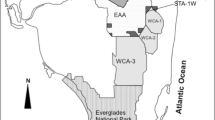Abstract
Biomass production and, chemical cycling were evaluated in a man-made wetland created using geothermal water in southcentral Idaho. The wetland system consisted of a 0.25 ha area divided into two ponds. The upper pond contained submerged species (Egeria, pondweeds and coontail); the lower pond was planted with emergents (cattail, bulrush, and common reed). Biomass production from emergent plants in a two-year-old system compared favorably with production values reported in the literature for natural wetlands. Chemical cycling of potassium (K) was evaluated through the lower pond system. Uptake of several other constituents (F and Na) of the geothermal water by the emergent plants was observed. However, there was little difference in elemental concentrations of the system’s influent and effluent, probably due to evapotranspiration of water which effectively concentrates elements in the remaining water.
Twenty-one species of diatoms were identified in the geothermal wetland, and numerous species of insects were observed. The human-made wetland also created substantial habitat for wildlife. This type of system could be used as an alternative to injection of spent geothermal fluids from small-scale projects. Results of this study indicate that a wetland system can be developed to produce substantial quantities of biomass in a cold desert environment.
Similar content being viewed by others
Literature Cited
Black, C. A., D. D. Evans, J. L. White, L. E. Ensminger, F. E. Clark, 1965, Methods of Soil Analysis, Agronomy No. 9., American Society of Agronomy, Wisconsin, USA.
Blumer, K. 1978, The Use of Wetlands for Treating Wastes-Wisdom in Diversity, BNL-24611, March.
Boyd, C. E. 1969, Production, mineral nutrient absorption and biochemical assimilaton by Justica americana and Alternanthera philoxeroides. Arch. Hydrobiol. 66: 139–160.
Boyd, C. E. 1970, Production, mineral nutrient absorption and biochemical assimilaton inTypha latifolia andScirpus americanus. Ecology, 51: 285–290.
Boyd, C. E., and J. M. Lawrence. 1976, The Mineral Composition of Several Freshwater Algai. Proceedings of the Twentieth Annual Conference Southeastern Association of Fish and Game Commissioners, 413–424.
Breckenridge, R. P., L. S. Cahn, T. L. Thurow. 1982. “Biological Treatments and Uses of Geothermal Water as Alternatives to Injection,” Geothermal Resources Council Bulletin Vol. 11, No. 4: 3–6.
CH2M Hill. 1981, Utilization of Geothermal Effluents to Create Waterfowl Wetlands, FWS/10BS-B1/44.
Good, R. E., D. E. Wigham and R. L. Simpson. 1978, Freshwater Wetlands: Ecological Processes and Management Potential, New York, Academic Press, 3–21.
Gordon, O. H. 1980, Some Adaptations of Marsh Nesting Blackbirds. Monograph in Population Biology, No. 14, Princeton University Press, Princeton, NJ, 78–79.
Greig-Smith, P., 1964, Quantitative Plant Ecology, London: Butterworth.
Kershaw, K. A. 1964, Quantitative and Dynamic Ecology, London: Edward Arnold Publ.
Mayes, R. A., A. W. McIntosh, V. L. Anderson. 1977, “Uptake of Cadmium and Lead by a Rooted Aquatic Macrophyte (Elodea canadensis),” Ecology. 58: 1176–1186.
Melbrooks, J. E., and S. C. Reed. 1981, The Flowering of Wastewater Treatment, Water/Engineering and Management, June: 51–54.
Nichols, D. S. 1983, Capacity of Natural Wetlands to Remove Nutrients from Wastewater, Journal WPCF, Volume 55, Number 5, 495–503.
Ondok, J. P. 1970, The Horizontal Structure of Reed Stands (Phragmites communis) and its Relation to Productivity, Presia, 42: 256–261.
Ondok, J. P. 1971, Indirect estimation of primary values used in growth analysis. In: Plant Photosynthetic Production, Manual of Methods, Sestak, Z., Catsky, J., Jarvis, P. G. (eds.). The Hague: Dr. W. Junk, N. V., Publishers: 392–141.
Perkin Elmer Corp., 1976 “Analytical Methods for Atomic Absorption Spectrophotometry”, September.
Standard Methods for the Examination of Water and Wastewater. 1981, 15th Edition.
Stanley, N. E., T. L. Thurow, B. F. Russel, J. F. Sullivan. 1980 Geothermal Wetlands: An Annotated Bibliography of pertinent Literature, EGG-2029/UC-669.
Toubier, J., and Pierson, R. W., eds. 1976, Biological Control of Water Pollution, Philadelphia, PA: University of Pennsylvania Press.
Author information
Authors and Affiliations
Rights and permissions
About this article
Cite this article
Breckenridge, R.P., Wheeler, L.R. & Ginsburg, J.F. Biomass production and chemical cycling in a man made geothermal wetland. Wetlands 3, 26–43 (1983). https://doi.org/10.1007/BF03160729
Issue Date:
DOI: https://doi.org/10.1007/BF03160729




